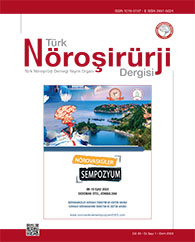2Department of Neurologic Surgery, Bilkent City Hospital, Ankara, Turkey
3Department of Radiology, Bilkent City Hospital, Ankara, Turkey
Özet
Background: Flow diverter devices are used for successful endovascular treatments protecting important perforating branches during aneurysm embolization. Since these treatments are performed under anti-platelet therapy, acute flow-diverter treatments in ruptured aneurysms are still controversial. Acute coil embolization followed by flow diversion has emerged as an intriguing and feasible treatment option for ruptured anterior choroidal artery aneurysm treatment.Methods: This is a single-center retrospective case series study between March 2011 and May 2021. Patients with ruptured anterior choroidal aneurysms underwent flow-diverter therapy in a different session following acute coil embolization. Patients treated with primary coiling or embolization with only flow diversion devices were excluded. Preoperative demographic and presenting symptoms, aneurysm morphology, perioperative and postoperative complications, and long-term clinical and angiographic outcome were measured using the modified Rankin scale, O"Kelly Morata Grading scale, and Raymond Roy occlusion classification, respectively.
Results: A total of 16 patients underwent coiling in the acute phase to undergo flow diversion later. The mean maximum aneurysm diameter is 5.44±3.39. All patients had a subarachnoid hemorrhage and were treated acutely between days 0-3 of acute bleeding. The mean age at the presentation was 54.12±12 years (32-73 years). Two patients (%12.5) had minor ischemic complications, which are seen on MRA as clinically silent infarcts, after the procedure. One patient (%6.2) had a technical complication with the flow diverter device shortening and deployed a second flow diverter telescopically. No mortality or permanent morbidity was reported. The mean interval time between the two treatments was 24.06±11.83 days. All patients follow-up with DSA; 14/16(%87.5). patients had aneurysms that were completely occluded and 2/16(%12.5) showed near complete occlusion. The mean follow-up period was 16.62±3.22 months, and all patients had mRS scores ? 2. 14/16 (87.5%) with a total occlusion 4/16(%87.5) and near complete occlusion of aneurysms None of the patients had retreatment or rebleeding.
Conclusions: Staged treatment of ruptured anterior choroidal artery aneurysms with acute coiling embolization and flow-diverter treatment following recovery from SAH is safe and effective. In this series, no cases of rebleeding occurred during the interval between coiling and flow diversion. Staged treatment should be considered a valid option in patients with challenging ruptured anterior choroidal aneurysms.

